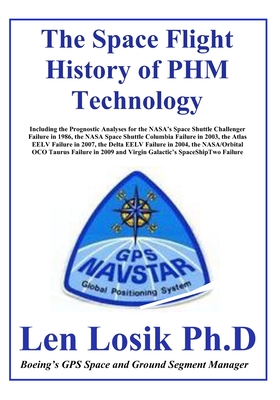You are here
Back to topThe Space Flight History of PHM Technology (Paperback)
$89.95
Usually Ships in 1-5 Days
Description
The Space Flight History of PHM Technology describes the 30 years the author incorporated PHM technology he developed for GPS satellites as the Boeing GPS Space and Ground Segment Manager on contract to the U.S. Air Force to win funding for the GPS program by the department of Defense. The results of his routine prognostic analysis were used to improve the design of the future 52 GPS Block , A and F satellites. Also included are the results of the author's work to use PHM technology in the design and test of U.S. civil, military and NASA spacecraft, missiles and launch vehicles and international civil and government and satellites and launch vehicles. Also included is the independent validation of PHM technology by Lockheed martin reliability analysis engineers at the Advanced Development Dept. in Sunnyvale Ca. Lockheed Martin enginers used their proprietary software used for pattern recognition of torpedo wakes from submarine launched torpedoes to identify the presence of premature aging in NASA's Extreme Ultra Violet Explorer class subsystem equipment telemetry and the satellite's telescope detector's analog telemetry. The $700M EUVE satellite was a collaboration between NASA and U.C. Berkeley's Space Science Laboratory. The NASA EUVE satellite was a low earth orbiting, space science satellite, one of many sister-ships to the NASA Hubble orbiting telescope. The results of the author's prognostic analysis was used to close the mission control center and call engineers only when an equipment failure was predicted, the budget saved by closing the EUVE payload mission control center was used to extend the EUVE satellite's space science mission from 1995 to 2002, when the EUVE satellite re-entered the earth's atmosphere and landed in Egypt's desert. Also included is the first technical paper published about PHM technology in 1996 by the author and Lockheed Martin's Space Systems Engineers in the Advance Development Dept. engineer's independent validation of the author's prognostic analysis using his proprietary predictive algorithms to process the NASA EUVE satellite's subsystem equipment's telemetry that illustrated the premature aging allowing the author to predict which EUVE satellite's equipment were going to fail and each unit's remaining usable life was going to be with certainty prior to each equipment failure. Included is the results of the prognostic analysis regarding the author's predicted satellite subsystem and payload equipment remaining usable life that were 100% accurate, there were no false positives and no false negatives using the author's proprietary, predictive algorithms in completing his prognostic analysis.
About the Author
The author is an award winning spacecraft designer, winning awards from Boeing and the U.S. the Air Force for winning funding of the GPS program by the DoD as the Boeing GPS Space & Ground Segment Manager. The author pioneered the use of predictive algorithms on the GPS Block I satellites to illustrate and identify the presence of premature aging in GPS satellite subsystem and payload equipment analog telemetry and determine remaining usable life as the Boeing/Air Force's GPS Space and Ground Segment Manager. The author completed a prognostic analysis on telemetry from GPS satellites at the factory, on the launch pad and on on-orbit as well as on the General Dynamics Atlas E/F launch vehicles used to launch GPS Block I satellites into a 63 degree inclination, 12 hour, 10,900 nmi. altitude circular orbit beginning in 1979. As the NASA GOES Next Spacecraft Manager, the author completed a prognostic analysis only on the first GOES Next satellite (GOES 8 on-orbit) satellite that did not experience any premature failures and went on to operate successfully for 8.5 years and was the only GOES Next to do so. The also completed a prognostic analysis on the United Technologies Titan solid rocket motor's thrust vector control valves and assemblies. As the Engineering Manager and then the Program Manager for the U.C. Berkeley/NASA EUVE low earth orbiting space science program at U.C. Berkeley, Space Sciences Laboratory, the author completed a prognostic analysis on the on-orbit NASA EUVE, low earth orbiting satellite in 1994 and 1995. The results were published in conjunction with Lockheed Martin reliability engineers from the Advanced Development Center located in Sunnyvale CA at the 1996 and 1997 International Telemetry Conference held in Las Vegas and San Diego. The Lockheed Martin reliability engineers used proprietary software to validate the results of the author's prognostic analysis on the NASA EUVE satellite equipment's telemetry and accuracy of prediction of remaining usable life. As a spacecraft TC&R/TT&C/C&DH subsystem engineer, the author led the design of the first 12 INTELSAT VII commercial, geostationary, communications satellites designed to use a PHM program to identify the equipment that was going to fail prematurely, earning the author a commendation from INTELSAT. The author also embedded predictive algorithms in Avaya, AT&T and Verizon telecom servers used in the public telephone switching network to meet a 99.999% availability requirement.
